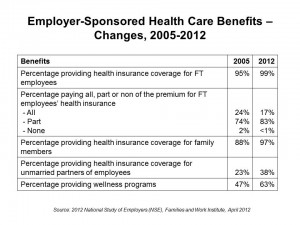 The most flexible workplaces are good for worker’s health: they yield the most engaged workforces, greater job satisfaction, increased commitment to the firm, better mental health and lower indicators of depression. But not all firms are all that flexible, which is the top line of the Family and Work Institute‘s 2012 National Study of Employers (NSE), funded by The Alfred P. Sloan Foundation.
The most flexible workplaces are good for worker’s health: they yield the most engaged workforces, greater job satisfaction, increased commitment to the firm, better mental health and lower indicators of depression. But not all firms are all that flexible, which is the top line of the Family and Work Institute‘s 2012 National Study of Employers (NSE), funded by The Alfred P. Sloan Foundation.
What makes this survey different from others polling employers is that the NSE looks at the comprehensive array of total benefits offered to employees and their changing needs in terms of family, finance, and social lives.
In the past seven years, with the advent of the Recession and subsequent slow-to-no recovery, employers’ benefits have substantially changed in two ways: first, employees have more options for flexible work in terms of time and place; and second, employers have reduced opportunities for part-time work. New fathers have less time to take off following childbirth, even in the wake of the Family and Medical Leave Act of 1993. While more employers are offering Dependent Care Assistance Plans to help workers pay for child care with pre-tax dollars, fewer companies provide emergency or sick care options. Most employers do provide Employee Assistance Programs to help workers deal with problems and pressures (up to 74% in 2012 from 46% in 2005). And as regular Health Populi readers will know, wellness programs proliferate workplaces: the NSE found that 63% of employers offer wellness programs vs. 47% in 2005.
While employers offering health insurance persists, especially among larger companies, employees must pick up larger portions of premiums and higher copays. Among companies offering health insurance, 17% pay all of the premiums, 83% pay some of the premiums. Smaller firms were less likely than large ones to have increased employees’ premium co-pays year-on-year. However, smaller firms were less likely to provide wellness programs than larger companies. It’s encouraging to see that more employers are offering health benefits to unmarried partners of employees – up from 23% in 2005 to 38% in 2012, as the chart shows.
Firms that offer greater flexibility tend to be: non-profits, larger, have more women in their employ, have fewer union workers, have fewer racial or ethnic minorities in the workforce, have fewer hourly employees, and have more women and racial or ethnic minorities in top/senior positions.
Health Populi’s Hot Points: It might seem rational to assume that in the post-recession period, U.S. employers would have reduced benefits and programs to assist workers. This is too simple a statement: while employees must have “more skin in the game” especially when it comes to health benefits, progressive employers are showing support through more artful design of benefits looking at whole-health and family and social dynamics, such as re-defining what is a “family.” By investing in greater flexibility for full-time workers, employers who do so are voting with dollars to promote whole health and lowering stress, which according to the employers polled by FWI yield greater productivity and company allegiance.




 Thank you FeedSpot for
Thank you FeedSpot for